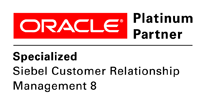Past Event: Nov 09, 2023
Retrouvez Boxfusion Consulting lors de l’événement Oracle Applications Unlimited Days, en France
1 min read

Author: Geraint Thomas
3 min read
With the introduction of Siebel Open UI, new avenues of development and design have become possible for Siebel. Open UI allows any UI, navigation model or UI control that you see anywhere on the web to now be implemented in Siebel. With the improved capabilities of Open UI we can now look at applying certain user experience (UX) concepts to Siebel.
UX is a hot topic for content-rich websites, but is it relevant when you are looking at transactional CRM applications such as Siebel? Most internal Siebel users have to use the application as part of the day-to-day routine. For example, Call centre agents will use the application to perform their role to retrieve customer information and log service requests, and Sales Reps will have some form of KPI that is linked to their use of the application.
The outcome of UX design is defined as the process of enhancing user satisfaction, so what is the business benefit of improving Siebel UX if users have no choice but to use the application? Some might say, "not much"; but we could look at UX from a slightly different perspective - that of enhancing the satisfaction of the business as a whole with Siebel, rather than explicitly end user satisfaction. We can thus use UX design principles to optimise how Siebel meets business objectives, and this, therefore, has an easily quantifiable ROI.
Traditional UX Metrics used to measure content rich websites include basket abandonment, subscribers, time on page or time on site - but these are not relevant for internal-facing Siebel applications. We, therefore, need to find a set of relevant UX metrics to use when designing new Siebel functionality or improving the performance of Siebel processes.
As Joe Leech over at cxpartners.co.uk highlights, for a metric to be useful it must have:
Taking this into account we have identified a list of metrics we perceive as relevant for optimising the business satisfaction of Siebel users (some of which would have been historically categorised under the cruder metric of “reduced clicks”). Obviously at the start of any project these metrics need to be defined in more detail with reference to the specific Siebel processes, functionality, and the overall business objectives of that particular customer. It is worth bearing in mind that additional UX metrics may need to be considered for Siebel applications that expose a Siebel UI to external user depending on the functionality exposed.
Process Metrics
Interaction Metrics
Navigation Metrics
Some of the metrics we can easily obtain by querying the Siebel database, while others require either monitoring user activity indirectly or the introduction of a script to monitor user behaviour directly.
Selecting appropriate metrics and introducing measurements can help you to clearly understand how the enhancements that you are delivering in Siebel Open UI are helping your users’ activities. If appropriate “cost benefits” are linked to each metric, you can in turn see how your Siebel Open UI enhancements are benefiting your business, providing a clear view of the ROI of your Siebel Open UI development programme.

For help with using Siebel UX metrics to underpin the definition of a business case for upgrading to, and taking full advantage of, Siebel Open UI, call us now on +44 203 283 4315, or use our Contact Form here.
1 min read
5 min read
5 min read